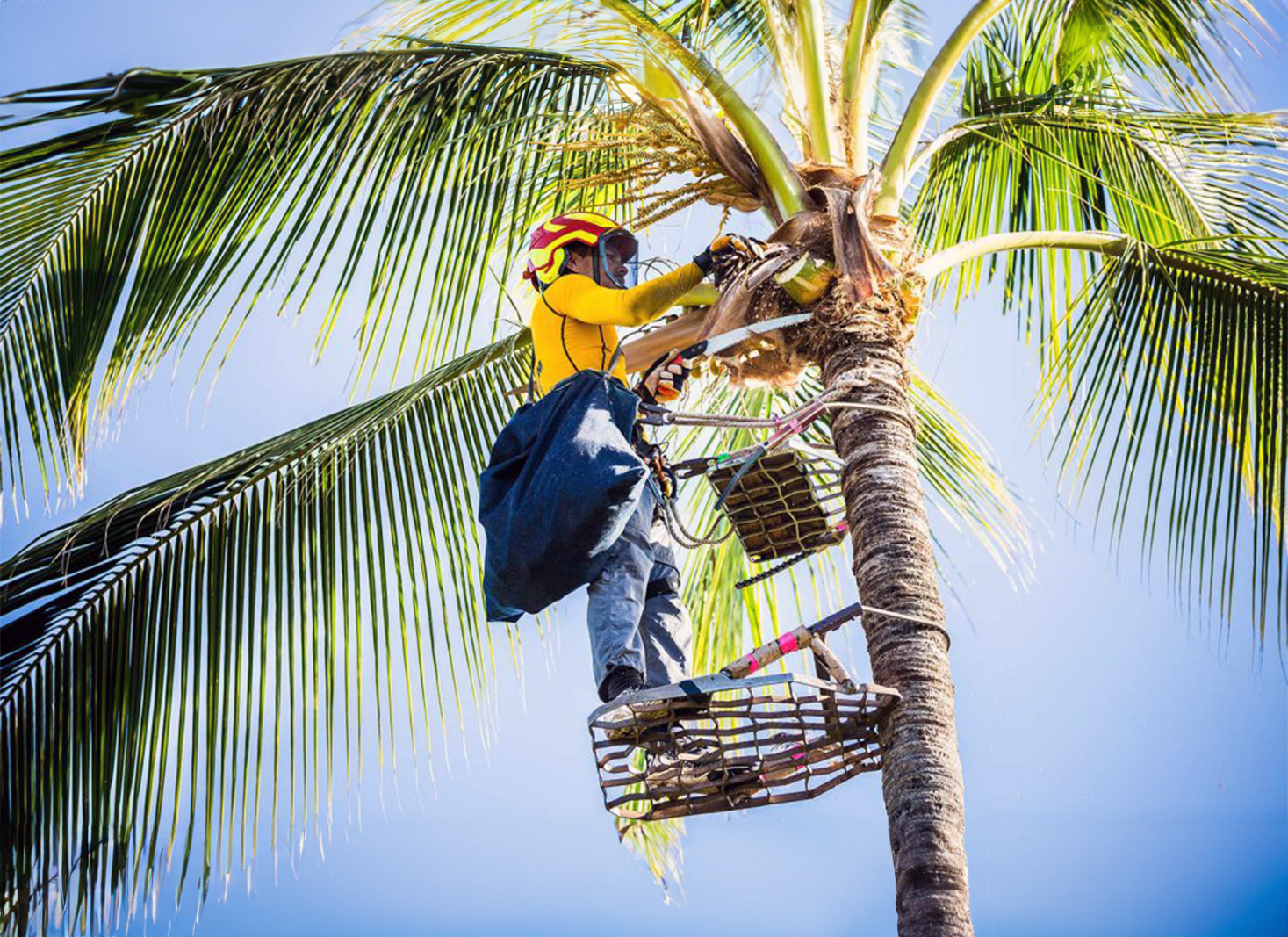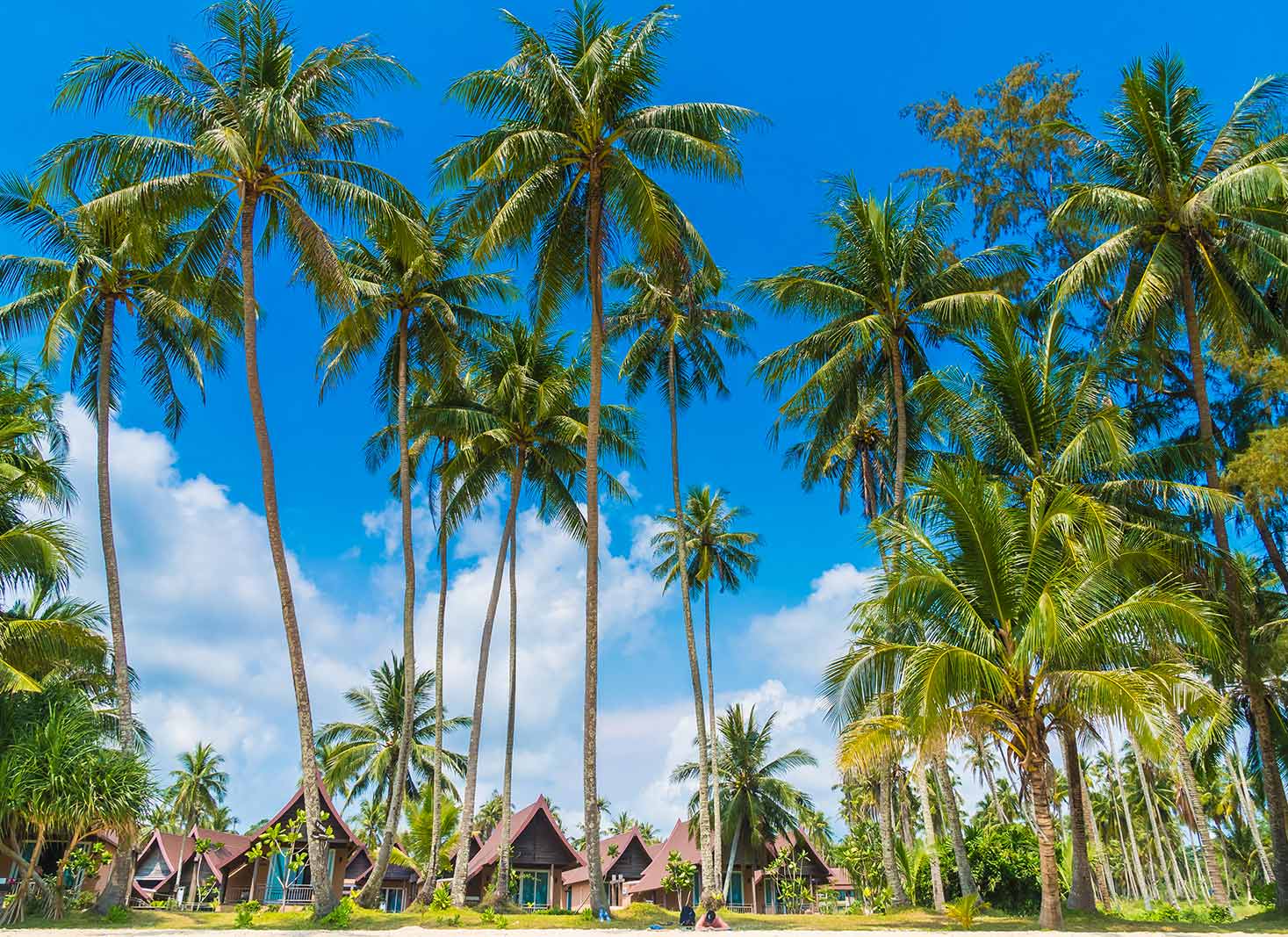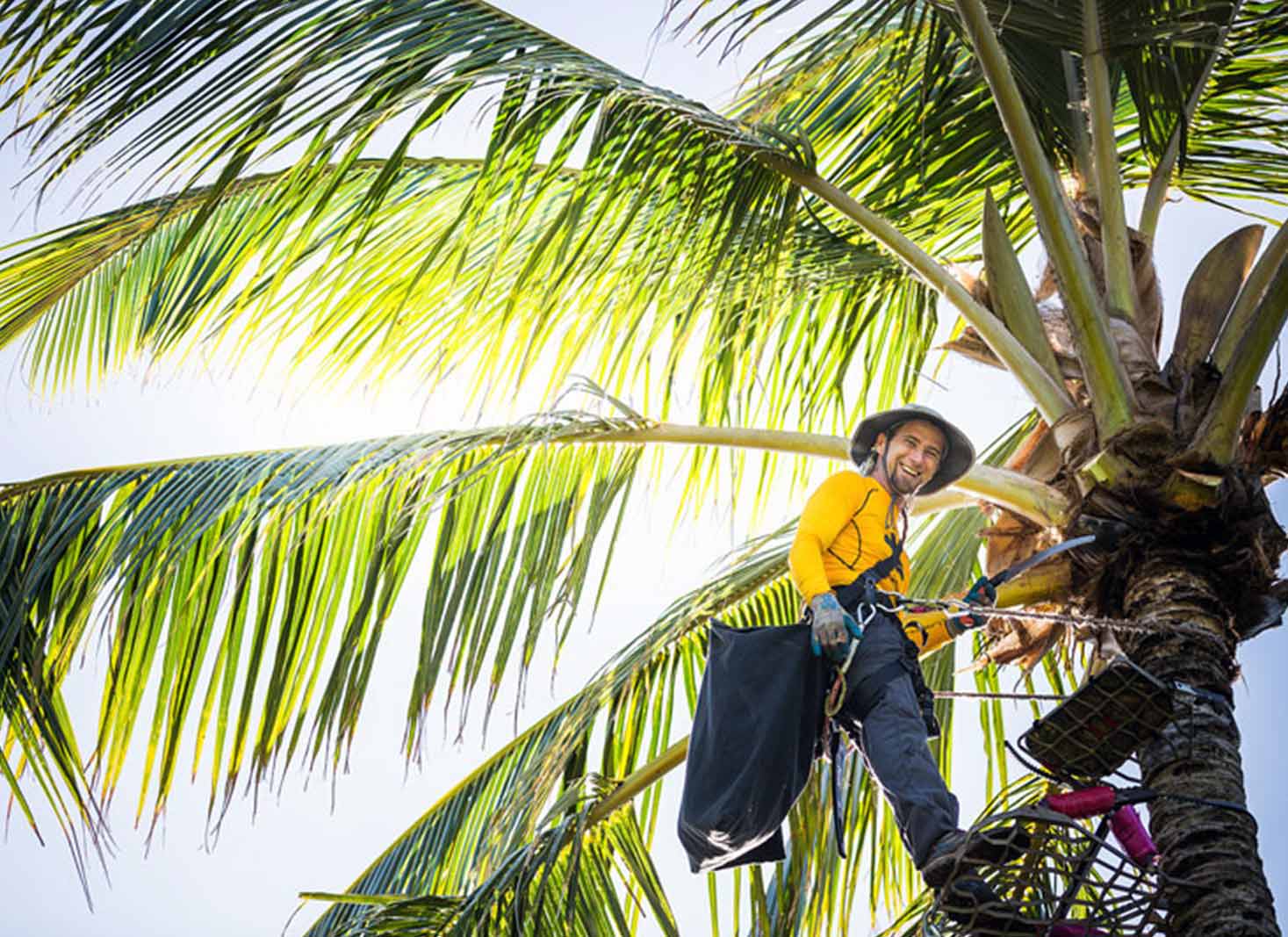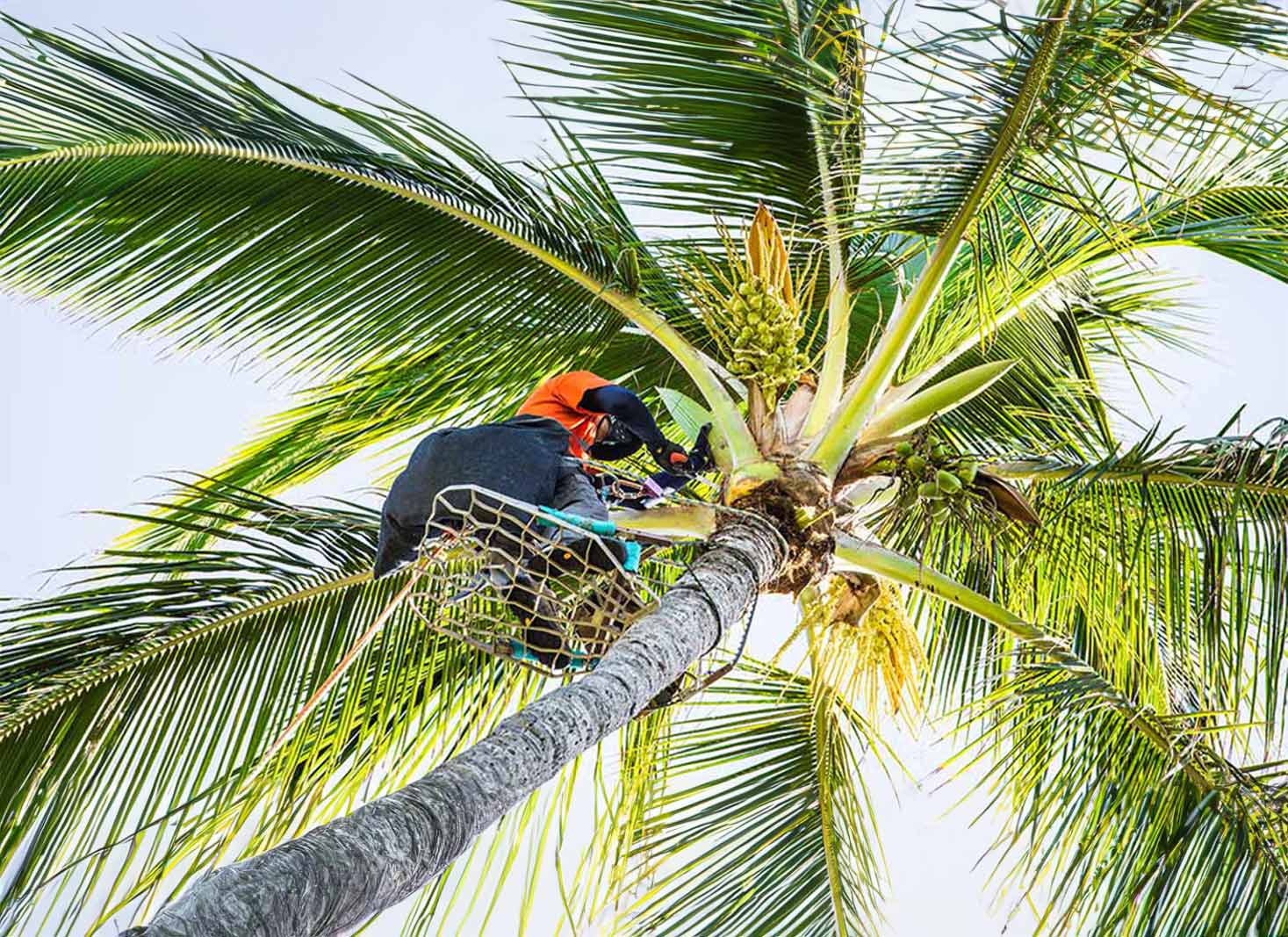Trimming your palm trees is crucial to maintaining their health and appearance. Considering factors such as tree height, location, and accessibility while researching local regulations and reputable service providers, you can ensure that your palm trees receive the best care while minimizing costs.
On average, trimming palm trees in Hawaii costs $322. The price can vary between $150 and $945 based on the palm tree size and species.
Palm tree trimming costs by tree size prices are below.

Average cost of palm tree trimming in Hawaii
The typical cost for palm tree trimming in Hawaii is $150 to $945, but factors such as tree height, location, and accessibility can significantly impact the cost.
For example, the estimated cost of trimming a 30- to 60-foot-tall palm tree in Hawaii ranges between $150 and $900.
| Tree Height | Average cost range |
|---|---|
| 15 - 30 ft. | $75 - $400 |
| 30 - 60 ft. | $150 - $900 |
| 60 - 80 ft | $250 - $1,100 |
| More than 80 ft. | $1,000 - $1,500 |
It is essential to note that trimming green fronds is not advisable, as they provide protection for the tree and, in their absence, the tree may become vulnerable to pests and disease.
The cost of palm tree trimming in Hawaii can also be influenced by the demand for services during specific times of the year.
Scheduling trimming during the off-season or opting for regular maintenance can help reduce costs and maintain the health of your palm trees.
Factors affecting palm tree trimming cost in Hawaii
Numerous factors can affect the cost of palm tree trimming in Hawaii, including:
- Height and size of the palm tree. For example, taller trees often require more effort and resources to trim, which can increase the overall cost.
- Accessibility of the palm tree. The location and accessibility of the tree can significantly impact the cost of trimming an extra-large palm tree in Hawaii.
- Number of palm trees that need to be trimmed. The more trees, the higher the trimming cost.
- Condition of the palm tree (e.g. diseased or damaged). Health problems can be expensive to address when it comes to palm tree trimming services. These issues can include fungal diseases, insect damage, cracks, and weak roots.
To prevent aggravating any issues and causing further damage to the tree, the tree service professional must take extra care and attention when trimming.
Should any health issues require attention as part of the trimming project, additional costs may be incurred. Tree pest control can add up to $250 to the total project cost. Tree removal costs may also need to be taken into account.
To minimize costs associated with palm tree trimming in Hawaii, it is suggested to:
- Trim palm trees no more than twice a year for optimal cost efficiency
- Schedule trimming during the off-season
- Regularly maintain your palm trees to ensure their health and minimize the necessity of costly trimming services.
Native and introduced palm trees in Hawaii

Hawaii is home to both native and introduced palm tree species, which can impact the cost of trimming. The palm tree species found in Hawaii are:
- Loulu palm (Pritchardia spp.) – native
- Coconut palm – introduced
- Date palm – introduced
- Bottle palm – introduced
Trimming native palms is often more expensive than trimming introduced palms due to the fact that native palms are often more expensive than introduced palms.
Native Hawaiian palm trees
Native Hawaiian palm trees, such as the Loulu palm, may have different trimming requirements and costs compared to introduced species.
The Loulu palm is the only native palm tree species present in Hawaii and plays a vital role in the local ecosystem. These palms can grow up to 60 feet tall and are characterized by their fan-shaped leaves and smooth, columnar trunks.
The Loulu palm is considered an endangered species, making it essential to approach their trimming with care and expertise.
The trimming requirements and costs of native Hawaiian palm trees, such as the Loulu palm, may vary from those of introduced species. This variation in cost may be attributed to:
- The endangered status of the Loulu palm, which requires specialized knowledge and expertise to trim properly
- Native palm trees may need more frequent maintenance due to their unique growth patterns
- Susceptibility to pests and diseases specific to the Hawaiian ecosystem
Introduced palm trees in Hawaii
Introduced palm trees in Hawaii, such as coconut, date, and bottle palms, may require different trimming techniques and costs.
These species were brought to Hawaii from other regions of the world and have become well-established in the local environment.
Coconut palms
Coconut palms, for example, are not native to Hawaii but are now widespread throughout the islands due to their adaptability and popularity as a landscape tree.
They can grow up to 100 feet tall and require specialized trimming techniques to maintain their health and appearance.
Date palms
Similarly, date palms and bottle palms are introduced species that have become prevalent in Hawaii. These palms also require specific trimming techniques and maintenance schedules to ensure their health and longevity.
The trimming techniques and associated costs required for introduced palm trees in Hawaii will vary depending on the species.
It is essential to consult with a professional palm tree trimming service to determine the appropriate trimming techniques and costs for your specific palm tree species.
Hiring a professional vs. DIY palm tree trimming in Hawaii
Deciding between hiring a professional or attempting DIY palm tree trimming in Hawaii depends on factors such as safety, expertise, and overall cost.
While it may seem more cost-effective to trim your palm trees yourself, the risks and challenges associated with DIY trimming can lead to injuries, property damage, and higher costs in the long run.
Benefits of hiring a professional
Hiring a professional for palm tree trimming in Hawaii ensures proper trimming techniques, safety measures, and potentially additional services.
Professionals have the necessary equipment, insurance coverage, and expertise to handle palm tree trimming safely and efficiently, eliminating the risks associated with DIY trimming.
Moreover, a professional service can guarantee that your trees are properly maintained, aesthetically pleasing, and healthy by removing dead or dying fronds and promoting the overall health of the tree.
Additionally, hiring a professional palm tree trimming service in Hawaii can help you in the following ways:
- Navigate local regulations and permits, avoiding potential fines or penalties
- Ensure compliance with specific trimming requirements for native and introduced palm tree species
- Provide appropriate care and maintenance needed to help your trees thrive
Risks and challenges of DIY trimming
DIY tree trimming can be risky and challenging, potentially leading to injuries, property damage, and higher costs in the long run. Using hazardous equipment such as chippers, chainsaws, and aerial lifts can lead to accidents and injuries.
Moreover, incorrect trimming techniques can cause damage to the tree, leaving it vulnerable to pests and diseases. In some cases, improper trimming can even result in the death of the tree, necessitating costly removal services.
Another challenge of DIY palm tree trimming is the potential for property damage, especially when dealing with dead fronds.
In such cases, it might be wise to consider professional palm tree removal services to ensure safety and prevent property damage, or investing in proper palm tree trimming tools to minimize risks.
Tips for saving money on palm tree trimming in Hawaii

Tips for saving money on palm tree trimming in Hawaii include scheduling off-season trimming and maintaining regular tree maintenance.
By trimming your palm trees during the late spring and early summer months when demand for services is typically lower, you can take advantage of reduced costs.
Additionally, regular maintenance of your palm trees can prevent the need for more extensive and costly trimming services, ensuring the health and appearance of your trees year-round.
Off-season trimming
During the late spring and early summer months, many homeowners and businesses schedule their palm tree trimming, leading to a decrease in demand for services and a corresponding decrease in costs.
By scheduling your palm tree trimming during this off-season period, you can take advantage of these reduced costs and potentially save money on your overall palm tree maintenance expenses.
It is crucial to be mindful of the potential risks and challenges associated with off-season trimming. Unpredictable weather, such as storms and strong winds, can cause damage to the tree or the surrounding property.
It is essential to weigh the cost savings against the potential risks and challenges of off-season trimming before making a decision.
Regular maintenance
By consistently monitoring your palm trees and addressing any issues as they arise, such as removing damaged or diseased fronds, you can maintain the health and appearance of your trees and avoid potential risks.
It is recommended that palm trees be trimmed no more than twice a year to ensure optimal cost efficiency.
In addition to the cost savings, regular maintenance of your palm trees in Hawaii can provide several benefits. These include enhancing the visual appeal of your trees, promoting healthy growth, and reducing the risk of pests and diseases.
By investing in regular maintenance, you can ensure the long-term health and beauty of your palm trees while minimizing the overall costs associated with palm tree trimming.
Palm tree trimming regulations and permits in Hawaii
Palm tree trimming regulations and permits in Hawaii may vary by location and tree type, so it’s essential to research local requirements before proceeding with trimming.
While no specific permits are required for palm tree trimming in Hawaii, a Tree Trimming and Removal Contractor’s license (C-27) must be held by companies or arborists who perform tree trimming operations at a height of 10 ft or higher.
Finding a reputable palm tree trimming service in Hawaii

Finding a reputable palm tree trimming service in Hawaii involves researching reviews, verifying credentials, and ensuring the company has proper insurance coverage.
By taking the time to thoroughly research and vet potential service providers, you can ensure that you find a reliable and trustworthy company to handle your palm tree trimming needs.
Research and reviews
Researching and reading reviews of palm tree trimming services in Hawaii can help identify reputable and reliable companies.
Online reviews and ratings
Online reviews and ratings can provide valuable insights into the quality of service, professionalism, and overall customer satisfaction of local tree service companies.
By taking the time to read customer feedback and assess the overall reputation of a company, you can make an informed decision when selecting a palm tree trimming service in Hawaii.
Recommendations
In addition to online reviews, consider asking for recommendations from friends, family, or neighbors who have had positive experiences with palm tree trimming services in Hawaii.
Word-of-mouth referrals can often provide a more personal and trustworthy account of a company’s services, helping to ensure that you choose a reputable provider for your palm tree trimming needs.
Verify credentials and insurance
Verifying credentials and insurance coverage of a palm tree trimming service in Hawaii ensures the company is qualified and protects against potential liabilities.
When considering a palm tree trimming service, it is important to confirm certifications, licenses, and insurance coverage.
Ensuring that a company has the necessary qualifications and protection against potential liabilities can provide peace of mind and protect you from unexpected costs or damages.
FAQ's
The cost of trimming a tall palm tree will generally range from $200 to $1,200, depending on the height and condition of the tree.
When pruning a palm tree, you should only remove dead or dying fronds. Trimming the tree from 9-to-3 or 10-to-2 is recommended. Prune no more than 1-2 times per year.
Palm trees should be trimmed 1-2 times a year, preferably during the spring or summer months when the fronds are protected from cooler weather. Dead fronds should be removed as soon as they become visible.
For best results, trim your palm trees in late spring or early summer when the weather has warmed up to remove dead fronds, flower stalks, and fruit.











